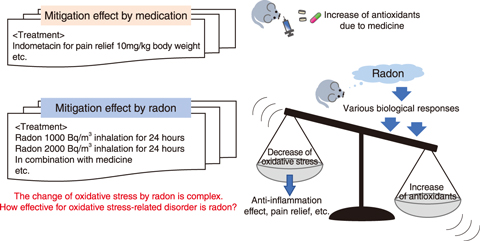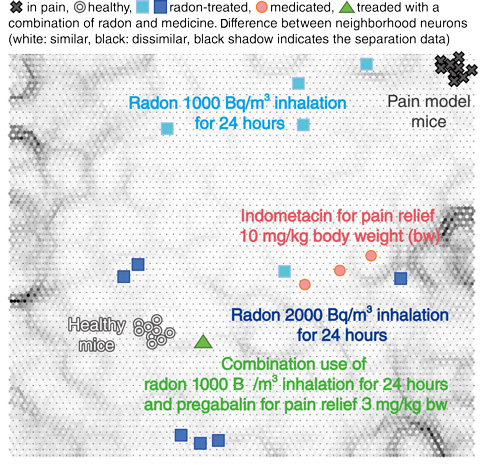
Fig.8-6 Input data for data analysis

Fig.8-7 Example output map using SOM
Misasa Hot Springs in Tottori Prefecture, Japan, approximately 30 min by car from Ningyo-toge Environmental Engineering Center, is known as a radioactive hot spring containing radon. Radon hot springs have been used as alternative medicine, although their impact on human health has not been clarified. Therefore, in collaboration with Okayama University, a study focusing on clarifying the mechanism behind the low-dose radiation and how to measure its effect on human health has been performed. As a result, the increase in antioxidant ability by radon was found to inhibit oxidative stress-related disorders. However, evaluating the effectiveness of low-dose radon radiation on alleviating oxidative stress-related disorders is difficult because there are many factors of oxidative stress, not only radiation, and the biological responses are complex. The analytical data used had been collected from reports demonstrating the mitigation of the disorder in mice by low-dose radiation when compared with medication, as summarized in Fig.8-6. In particular, the state of oxidative stress is more complex due to the mix of various biological reactions that occur due to radon exposure. To clarify this data, a machine-learning approach was considered, which would allow complex information to be evaluated, given that the provided data regarding the antioxidant ability affected by radon treatments can be classified and visualized. A self-organizing map (SOM), which is a tool to place data with similar characteristics close together, was employed to visualize data similarities.
A SOM is an unsupervised artificial neural network of competitive machine learning. Briefly, the neurons, which have a vector of the same form (high dimension) as the input data, learn the input data (multiplied by the learning rate) and then place data with similar characteristics close together. The resulting map output by the SOM has no axes; rather, it is a grayscale map demonstrating the regional difference between adjacent neurons, as the topology of the neurons on the map is important. SOMs allow for the comprehensive evaluation of information by dimension reduction and visualization.
The resulting output map with some data points labeled as examples is shown in Fig.8-7. Here, the space between the healthy mice and mice in pain shows little color change, indicating little change in the studied characteristic of their data. Although the plots of the mice in pain and those dosed with 1000 Bq/m3 of radon inhalation for 24 h are close together, the thin black shadow separating them indicates a greater change in their health characteristics (i.e., the mitigation effect). The complex nature of the data caused the data to be scattered across the map; however, data points representing mice treated with higher radon concentrations were closer to those representing healthy mice than untreated mice. This indicates the concentration dependence of radon, the effect of radon relative to medicine, and the combined effect of radon and medicine. Therefore, radon may be used as an alternative for pain relief and may have a combined effect with medicine.
In this study, SOM was used to evaluate the complex biological effects of low-dose radiation. Future work will focus on improving the algorithm of SOM to apply to the biological effects of various environmental factors other than radon.
(Norie Kanzaki)